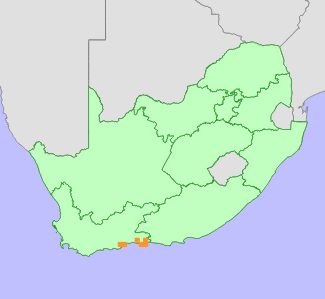|
Scientific Name | Muraltia knysnaensis Levyns |
Higher Classification | Dicotyledons |
Family | POLYGALACEAE |
Common Names | Knysna Butterflybush (e) |
National Status |
Status and Criteria | Endangered B1ab(ii,iii,iv,v) |
Assessment Date | 2012/02/28 |
Assessor(s) | N.A. Helme, D. Raimondo, D. Turner & L. von Staden |
Justification | EOO 2046 km², between three and eight severely fragmented subpopulations remain on remnants of natural habitat after most of this species' habitat has been transformed for crop cultivation, forestry plantations and coastal development around Knysna and Plettenberg Bay. It continues to decline due to ongoing habitat degradation as a result of fire exclusion on small fragments. |
Distribution |
Endemism | South African endemic |
Provincial distribution | Western Cape |
Range | Coastal lowlands between Mossel Bay and the Keurbooms River. |
Habitat and Ecology |
Major system | Terrestrial |
Major habitats | Southern Afrotemperate Forest, South Outeniqua Sandstone Fynbos, North Langeberg Sandstone Fynbos, Garden Route Shale Fynbos, Albertinia Sand Fynbos, Southern Cape Dune Fynbos, Knysna Sand Fynbos, Hartenbos Dune Thicket, Goukamma Dune Thicket |
Description | Fynbos, on dry flats and hills. |
Threats |
| Muraltia knysnaensis's coastal fynbos habitat is already at least 58% transformed, mainly for crop cultivation, forestry plantations and urban and coastal development. Habitat loss is ongoing, and in addition, subpopulations surviving in small remnants of natural vegetation are threatened by alien invasive plant infestations and fire exclusion. |
Population |
Muraltia knysnaensis is known from only four recent records, and at three locations, plants are threatened by ongoing habitat loss, degradation and fragmentation. One subpopulation of fewer than 10 plants was found in 2009 on the edge of a newly established forestry plantation, and this subpopulation declined to only one plant in 2012 (D. Turner pers. obs. 2012). A fourth small subpopulation of fewer than 10 plants were recorded in a private nature reserve and is not threatened. Coastal fynbos within this species' known range is at least 58% transformed, however, at at least four other locations known through historical records intact habitat still remains, and it is likely that other subpopulations still exist. Due to extensive habitat transformation however, subpopulations have become isolated and are considered severely fragmented.
|
Population trend | Decreasing |
Assessment History |
Taxon assessed |
Status and Criteria |
Citation/Red List version | | Muraltia knysnaensis Levyns | VU B1ab(ii,iii,iv,v) | 2011.1 | | Muraltia knysnaensis Levyns | VU B1ab(ii,iii,iv,v) | Raimondo et al. (2009) | |
Bibliography |
Goldblatt, P. and Manning, J.C. 2000. Cape Plants: A conspectus of the Cape Flora of South Africa. Strelitzia 9. National Botanical Institute, Cape Town.
Levyns, M.R. 1954. The genus Muraltia. Journal of South African Botany Supplement 2:1-247.
Raimondo, D., von Staden, L., Foden, W., Victor, J.E., Helme, N.A., Turner, R.C., Kamundi, D.A. and Manyama, P.A. 2009. Red List of South African Plants. Strelitzia 25. South African National Biodiversity Institute, Pretoria.
|
Citation |
| Helme, N.A., Raimondo, D., Turner, D. & von Staden, L. 2012. Muraltia knysnaensis Levyns. National Assessment: Red List of South African Plants version 2024.1. Accessed on 2025/11/05 |
 Comment on this assessment
Comment on this assessment

